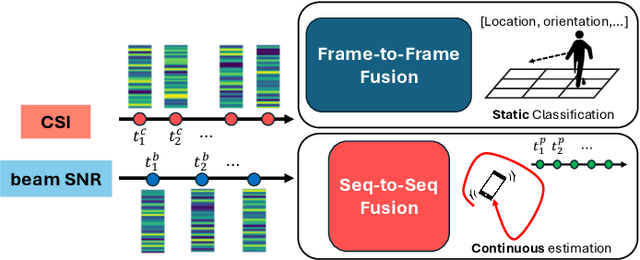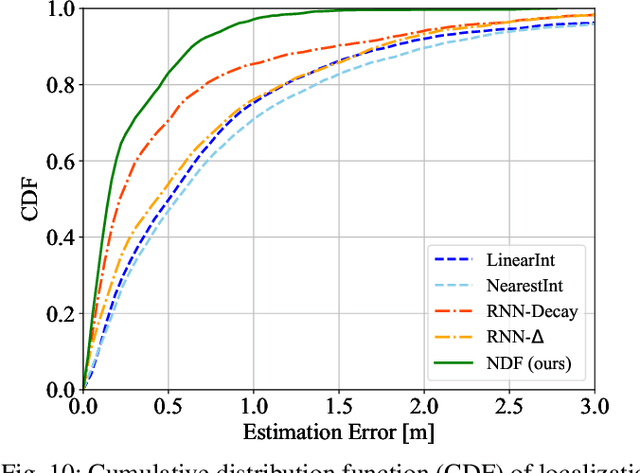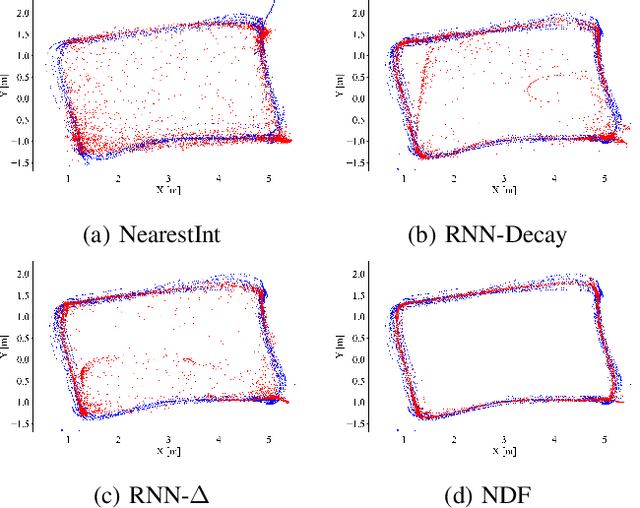Toshiaki Koike-Akino
Mitsubishi Electric Research Labs, Cambridge, MA, USA
Range Image-Based Implicit Neural Compression for LiDAR Point Clouds
Apr 24, 2025Abstract:This paper presents a novel scheme to efficiently compress Light Detection and Ranging~(LiDAR) point clouds, enabling high-precision 3D scene archives, and such archives pave the way for a detailed understanding of the corresponding 3D scenes. We focus on 2D range images~(RIs) as a lightweight format for representing 3D LiDAR observations. Although conventional image compression techniques can be adapted to improve compression efficiency for RIs, their practical performance is expected to be limited due to differences in bit precision and the distinct pixel value distribution characteristics between natural images and RIs. We propose a novel implicit neural representation~(INR)--based RI compression method that effectively handles floating-point valued pixels. The proposed method divides RIs into depth and mask images and compresses them using patch-wise and pixel-wise INR architectures with model pruning and quantization, respectively. Experiments on the KITTI dataset show that the proposed method outperforms existing image, point cloud, RI, and INR-based compression methods in terms of 3D reconstruction and detection quality at low bitrates and decoding latency.
Quantum-PEFT: Ultra parameter-efficient fine-tuning
Mar 07, 2025Abstract:This paper introduces Quantum-PEFT that leverages quantum computations for parameter-efficient fine-tuning (PEFT). Unlike other additive PEFT methods, such as low-rank adaptation (LoRA), Quantum-PEFT exploits an underlying full-rank yet surprisingly parameter efficient quantum unitary parameterization. With the use of Pauli parameterization, the number of trainable parameters grows only logarithmically with the ambient dimension, as opposed to linearly as in LoRA-based PEFT methods. Quantum-PEFT achieves vanishingly smaller number of trainable parameters than the lowest-rank LoRA as dimensions grow, enhancing parameter efficiency while maintaining a competitive performance. We apply Quantum-PEFT to several transfer learning benchmarks in language and vision, demonstrating significant advantages in parameter efficiency.
Winning Big with Small Models: Knowledge Distillation vs. Self-Training for Reducing Hallucination in QA Agents
Feb 26, 2025Abstract:The deployment of Large Language Models (LLMs) in customer support is constrained by hallucination-generating false information-and the high cost of proprietary models. To address these challenges, we propose a retrieval-augmented question-answering (QA) pipeline and explore how to balance human input and automation. Using a dataset of questions about a Samsung Smart TV user manual, we demonstrate that synthetic data generated by LLMs outperforms crowdsourced data in reducing hallucination in finetuned models. We also compare self-training (fine-tuning models on their own outputs) and knowledge distillation (fine-tuning on stronger models' outputs, e.g., GPT-4o), and find that self-training achieves comparable hallucination reduction. We conjecture that this surprising finding can be attributed to increased exposure bias issues in the knowledge distillation case and support this conjecture with post hoc analysis. We also improve robustness to unanswerable questions and retrieval failures with contextualized "I don't know" responses. These findings show that scalable, cost-efficient QA systems can be built using synthetic data and self-training with open-source models, reducing reliance on proprietary tools or costly human annotations.
Smoothed Embeddings for Robust Language Models
Jan 27, 2025



Abstract:Improving the safety and reliability of large language models (LLMs) is a crucial aspect of realizing trustworthy AI systems. Although alignment methods aim to suppress harmful content generation, LLMs are often still vulnerable to jailbreaking attacks that employ adversarial inputs that subvert alignment and induce harmful outputs. We propose the Randomized Embedding Smoothing and Token Aggregation (RESTA) defense, which adds random noise to the embedding vectors and performs aggregation during the generation of each output token, with the aim of better preserving semantic information. Our experiments demonstrate that our approach achieves superior robustness versus utility tradeoffs compared to the baseline defenses.
Quantum Implicit Neural Compression
Dec 19, 2024Abstract:Signal compression based on implicit neural representation (INR) is an emerging technique to represent multimedia signals with a small number of bits. While INR-based signal compression achieves high-quality reconstruction for relatively low-resolution signals, the accuracy of high-frequency details is significantly degraded with a small model. To improve the compression efficiency of INR, we introduce quantum INR (quINR), which leverages the exponentially rich expressivity of quantum neural networks for data compression. Evaluations using some benchmark datasets show that the proposed quINR-based compression could improve rate-distortion performance in image compression compared with traditional codecs and classic INR-based coding methods, up to 1.2dB gain.
Quantum Diffusion Models for Few-Shot Learning
Nov 06, 2024



Abstract:Modern quantum machine learning (QML) methods involve the variational optimization of parameterized quantum circuits on training datasets, followed by predictions on testing datasets. Most state-of-the-art QML algorithms currently lack practical advantages due to their limited learning capabilities, especially in few-shot learning tasks. In this work, we propose three new frameworks employing quantum diffusion model (QDM) as a solution for the few-shot learning: label-guided generation inference (LGGI); label-guided denoising inference (LGDI); and label-guided noise addition inference (LGNAI). Experimental results demonstrate that our proposed algorithms significantly outperform existing methods.
Exploring User-level Gradient Inversion with a Diffusion Prior
Sep 11, 2024



Abstract:We explore user-level gradient inversion as a new attack surface in distributed learning. We first investigate existing attacks on their ability to make inferences about private information beyond training data reconstruction. Motivated by the low reconstruction quality of existing methods, we propose a novel gradient inversion attack that applies a denoising diffusion model as a strong image prior in order to enhance recovery in the large batch setting. Unlike traditional attacks, which aim to reconstruct individual samples and suffer at large batch and image sizes, our approach instead aims to recover a representative image that captures the sensitive shared semantic information corresponding to the underlying user. Our experiments with face images demonstrate the ability of our methods to recover realistic facial images along with private user attributes.
Forget to Flourish: Leveraging Machine-Unlearning on Pretrained Language Models for Privacy Leakage
Aug 30, 2024Abstract:Fine-tuning large language models on private data for downstream applications poses significant privacy risks in potentially exposing sensitive information. Several popular community platforms now offer convenient distribution of a large variety of pre-trained models, allowing anyone to publish without rigorous verification. This scenario creates a privacy threat, as pre-trained models can be intentionally crafted to compromise the privacy of fine-tuning datasets. In this study, we introduce a novel poisoning technique that uses model-unlearning as an attack tool. This approach manipulates a pre-trained language model to increase the leakage of private data during the fine-tuning process. Our method enhances both membership inference and data extraction attacks while preserving model utility. Experimental results across different models, datasets, and fine-tuning setups demonstrate that our attacks significantly surpass baseline performance. This work serves as a cautionary note for users who download pre-trained models from unverified sources, highlighting the potential risks involved.
Analyzing Inference Privacy Risks Through Gradients in Machine Learning
Aug 29, 2024



Abstract:In distributed learning settings, models are iteratively updated with shared gradients computed from potentially sensitive user data. While previous work has studied various privacy risks of sharing gradients, our paper aims to provide a systematic approach to analyze private information leakage from gradients. We present a unified game-based framework that encompasses a broad range of attacks including attribute, property, distributional, and user disclosures. We investigate how different uncertainties of the adversary affect their inferential power via extensive experiments on five datasets across various data modalities. Our results demonstrate the inefficacy of solely relying on data aggregation to achieve privacy against inference attacks in distributed learning. We further evaluate five types of defenses, namely, gradient pruning, signed gradient descent, adversarial perturbations, variational information bottleneck, and differential privacy, under both static and adaptive adversary settings. We provide an information-theoretic view for analyzing the effectiveness of these defenses against inference from gradients. Finally, we introduce a method for auditing attribute inference privacy, improving the empirical estimation of worst-case privacy through crafting adversarial canary records.
Multi-Band Wi-Fi Neural Dynamic Fusion
Jul 17, 2024



Abstract:Wi-Fi channel measurements across different bands, e.g., sub-7-GHz and 60-GHz bands, are asynchronous due to the uncoordinated nature of distinct standards protocols, e.g., 802.11ac/ax/be and 802.11ad/ay. Multi-band Wi-Fi fusion has been considered before on a frame-to-frame basis for simple classification tasks, which does not require fine-time-scale alignment. In contrast, this paper considers asynchronous sequence-to-sequence fusion between sub-7-GHz channel state information (CSI) and 60-GHz beam signal-to-noise-ratio~(SNR)s for more challenging tasks such as continuous coordinate estimation. To handle the timing disparity between asynchronous multi-band Wi-Fi channel measurements, this paper proposes a multi-band neural dynamic fusion (NDF) framework. This framework uses separate encoders to embed the multi-band Wi-Fi measurement sequences to separate initial latent conditions. Using a continuous-time ordinary differential equation (ODE) modeling, these initial latent conditions are propagated to respective latent states of the multi-band channel measurements at the same time instances for a latent alignment and a post-ODE fusion, and at their original time instances for measurement reconstruction. We derive a customized loss function based on the variational evidence lower bound (ELBO) that balances between the multi-band measurement reconstruction and continuous coordinate estimation. We evaluate the NDF framework using an in-house multi-band Wi-Fi testbed and demonstrate substantial performance improvements over a comprehensive list of single-band and multi-band baseline methods.
 Add to Chrome
Add to Chrome Add to Firefox
Add to Firefox Add to Edge
Add to Edge